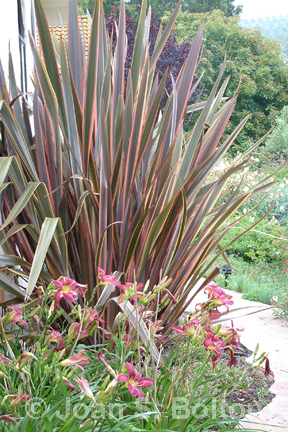
Spikes, both in solids and stripes.
That’s one of the top design trends for home gardens.
With yards shrinking in size, vertical plants slip more easily into the remaining, fertile spaces. Yet they work equally well in more expansive landscapes, where their erect forms provide punctuation points to softer, billowy plants or low-growing ground covers.
These strappy plants come in many shades of green, gray, blue, white, yellow, pink and burgundy. Their stalky leaves may be stiff and upright, or lax and cascading. They range from true grasses to strappy imposters. Many require little water and next to no care.
Ornamental Grasses
On the Central Coast, red fountain grass (Pennisetum ‘Rubrum’) may be the grand-daddy of decorative grasses. Introduced more than a decade ago, this popular grass bears fluffy, burgundy-tinged plumes. But with its robust growth to 4 to 5 feet tall and 5 to 6 feet wide, it has a tendency to overwhelm its neighbors. These days, a smaller version, dwarf red fountain grass (Pennisetum ‘Eaton Canyon’), is a more reasonable choice for most gardens. It tops out at 2 to 3 feet tall and 3 to 4 feet wide.
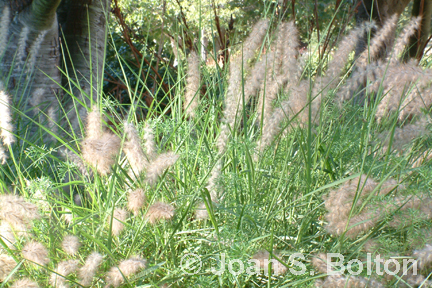
Chinese fountain grass (Pennisetum orientale) is smaller, reaching only 2 feet tall and wide. During late winter, its slender, medium-green blades may look a little random, or even weedy, to the undiscerning eye. But once it starts producing its pink-tinged inflorescences in spring, all is forgiven. Chinese fountain grass is at its best when planted in a swath. The plumes are incredibly soft. Cats love to bat them about.
Mexican feather grass (Nassella tenuissima) has one of the finest textures of any ornamental grass, and forms 2 to 3-foot tall billowy pillars of straw-colored stalks. Unfortunately, it tends to seed out prolifically, to the point that the California Department of Food and Agriculture lists it as a noxious weed in its “Encycloweedia.” Yet some folks still can’t seem to get enough of it.
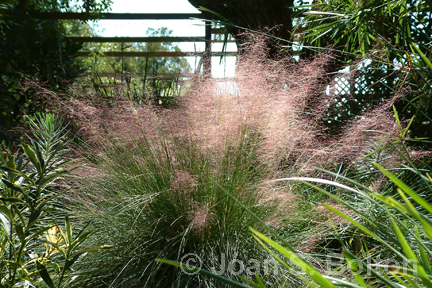
Hairy awn muhly (Muhlenbergia capillaris), which grows 2 to 3 feet tall and wide, also puts on a show of hundreds of delicate plumes, but it’s not a nuisance. Quite the contrary, it is a beautiful accent when planted solo. Place it where the setting sun shines through, and your afternoons and evenings in late summer and fall will never be the same.
Smaller-scale grasses include blue fescue (Festuca glauca ‘Elijah Blue’) and blue oat grass (Helictotrichon sempervirens). Both really do bear blue, stiff blades. They present similar profiles, remaining as individual clumps as they gain size. And they look great when planted out as lumpy meadows, especially on slopes or in sandier soils with good drainage.
Blue fescue reaches 8 to 10 inches tall and a foot to 18 inches wide, while blue oat grass grows about 2 feet tall and wide.
The Non-Grasses
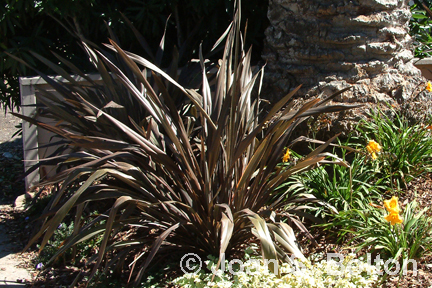
New Zealand flax (Phormium) has topped the list of spiky plants for years, with strappy leaves in a carnival of colors, ranging from outrageous stripes of hot pink, orange and yellow, to more muted shades of olive green and bronze.
But a host of other plants is giving the distinctive flaxes a run for their money.
Probably most similar, at first blush, are the new, trunkless cordylines.
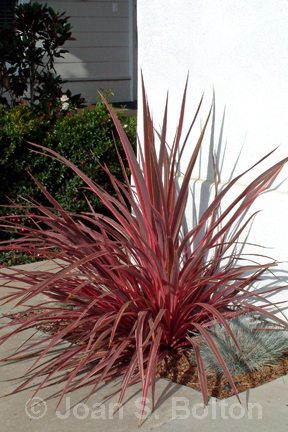
Now, trunking cordylines have been around for years. They look like New Zealand flax on a stick, with bare, skinny, ever-taller trunks and tufts of strappy leaves on top, in various shades or stripes of burgundy, bronze, yellow and green.
But new breeding is bringing us trunkless varieties, which remain as well-mannered, individual clumps on the ground.
Some bear leaves that are amazingly brilliant: Electric Pink cordyline is probably the most dazzling of the bunch, forming clumps 4 feet tall and wide of stiff, dark-pink leaves. Festival Grass is a darker shade of burgundy, while Renegade is such a deep purple that it’s almost black.
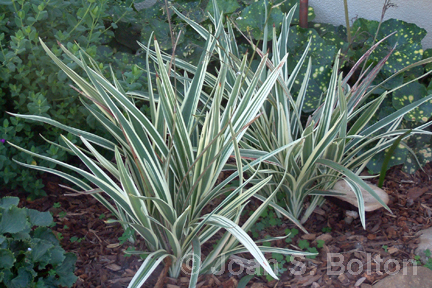
Tasman flax lilies form spreading colonies of upright clumps.
The variegated form (Dianella tasmanica ‘Variegata’) is currently one of my favorite plants. This beauty bears dark-green leaves with irregular, white stripes. It grows about 2 feet tall and wide, and is best in light shade, where those white stripes really brighten and highlight the surrounding plants. Plant it for those luscious leaves, rather than the tiny, inconspicuous blue flowers that occasionally rise above.
Out in the sun, Tasman flax lilies to look for include Baby Bliss and Little Rev. Both bear sturdy, blue-green leaves. Baby Bliss has stiff, upright leaves, each about an inch wide and 18 inches tall. Little Rev has narrower, but taller leaves, growing 2 to 3 feet tall. Both spread via rhizomes, slowly knitting together to form an interesting, erect ground cover.
Small mat rush (Lomandra confertifolia ‘Little Con’) looks more turf-like, and is soft to the touch. The slender leaves have a light, almost chartreuse cast, and grow about a foot tall and wide. A sister plant, dwarf mat rush (Lomandra longifolia ‘Breeze’), bears slender leaves in a traditional grass green and grows 2 to 3 feet tall and wide. Planted in mass, either one forms a nice, relaxed meadow look.

Smaller, still, are the many sedges (Carex). Depending on the species, they may remain as individual clumps, or run together. Also, unlike the plants previously mentioned, which are all low on water, some sedges guzzle the stuff. So be sure to read the plant tags carefully.
One of my low-water favorites is California meadow sedge (Carex praegracilis), which spreads via rhizomes. It’s a terrific lawn substitute as it tolerates some foot traffic. You can mow it or let it grow rumpled and wild.
Berkeley sedge (Carex divulsa) has a similar green, informal look, but is taller, and forms clumps that reach about 2 feet tall and wide.
≈
Planting and Care
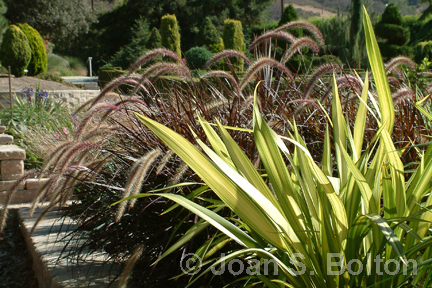
None of the spiky plants that I’ve mentioned needs special soil preparation. Don’t worry about adding amendments or pumping up the nutrients at planting time.
However, all will appreciate soil that drains reasonably well, and may not be happy if it takes days on end for puddles to disappear. If that’s the case in your garden, mound the soil or plant your new prizes in containers instead.
Also apply a mulch, 2 inches deep, to conserve soil moisture, moderate the temperature of the soil and hold down weeds.
Spiky plants benefit from drip irrigation, as they are not thrilled by water hitting their leaves. Any water spots can be unsightly, especially on darker foliage. And by virtue of their height, they may block sprinklers from reaching other plants in the garden. Irrigate occasionally, and as often and thoroughly as you would for other drought-tolerant plants. In gardens with heavy clay, this may be every two to three weeks during summer, for an hour at a time. In sandier soil, the cycle may be more frequent, but not for as long a duration.
In late winter, cut down your deciduous grasses to the ground, leaving a stubble only 4 to 6 inches tall. For the other verticals, occasionally trim all the way to the base any stalks that turn brown.
≈
Seeds of Wisdom
Leave plenty of room for your spiky plants. If you jam them against other plants, it will be difficult to appreciate their silhouette and form.
≈
Copyright, Joan S. Bolton. All rights reserved. Reproduction of text or photos in any form is prohibited without written permission.
≈
